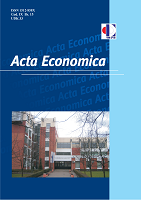НЕУРОНСКЕ МРЕЖЕ У ПРОГНОЗИРАЊУ ЕКОНОМСКОГ РАСТА КАО ИНДИКАТОРА КОНВЕРГЕНЦИЈЕ ИНТЕГРАЦИЈСКОГ ПРОЦЕСА
NEURAL NETWORKS IN FORECASTING ECONOMIC GROWTH AS A CONVERGENCE INDICATOR OF INTEGRATION PROCESS
Author(s): Brano Markić, Sanja Bijakšić, Arnela BevandaSubject(s): Policy, planning, forecast and speculation, Economic development, EU-Approach / EU-Accession / EU-Development
Published by: Економски факултет Универзитета у Бањој Луци
Keywords: neural networks; economic growth; gross domestic product; R language; convergence;
Summary/Abstract: Economic integration fosters income convergence by eliminating obstacles exchanged among member states, increasing competitiveness, facilitating access to advanced technologies and financial resources, and facilitating access to new knowledge. The result is a faster growth in income of the poorer members and this is one of the main economic reasons in favor of integration. However, each potential member has certain economic resources, a given economic structure that results in a certain growth rate measured by changes in GDP. The paper predicts economic growth using artificial neural networks. The results of the forecast provide a realistic evaluation of “readiness” of a particular economic system to converge to the level of average development (average GDP per capita) by comparing this estimated growth with the average growth rates of member states of integration. The work is based on the hypothesis that it is possible to produce an acceptable model which estimates GDP growth using artificial neural networks. Economic growth forecast is based on the relative contribution of agriculture, industry and services to the growth of gross domestic product. The reliability of the prognostic model of artificial neural networks is based on the error measured at the output layer of the neural network. It can be concluded from the results of the forecast that a neural network can be effectively implemented in applications of economic growth estimation.
Journal: Acta Economica
- Issue Year: 15/2017
- Issue No: 26
- Page Range: 179-197
- Page Count: 19
- Language: Serbian

